The Curia Calabra was a religious station or templum used for the ritual observation of the new moon in ancient Rome. Although its exact location is unclear, it was most likely a roofless enclosure in front of an augural hut (auguraculum), on the southwest flank of the Area Capitolina , the precinct of the Temple of Capitoline Jupiter. Servius identifies the Curia Calabra with a Casa Romuli ("Hut of Romulus") on the Capitoline, [1] but Macrobius implies that it was adjacent to the Casa. [2]
The Roman calendar was originally lunar. On the Kalends or first day of each month, the pontifex minor occupied the Curia Calabra to await the sighting of the new moon. The Rex Sacrificulus and the pontifex then carried out a res divina (religious service) and sacrifice in honor of Juno, and the Roman people were called to assembly (in comitia calata). Like calata, the name Calabra probably derives from calare, "to summon" or "proclaim". [3]

The Roman calendar was the calendar used by the Roman kingdom and republic. The term often includes the Julian calendar established by the reforms of the dictator Julius Caesar and emperor Augustus in the late 1st century BC and sometimes includes any system dated by inclusive counting towards months' kalends, nones, and ides in the Roman manner. The term usually excludes the Alexandrian calendar of Roman Egypt, which continued the unique months of that land's former calendar; the Byzantine calendar of the later Roman Empire, which usually dated the Roman months in the simple count of the ancient Greek calendars; and the Gregorian calendar, which refined the Julian system to bring it into still closer alignment with the tropical year.
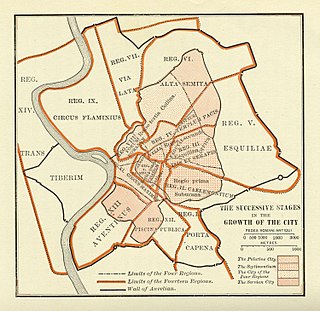
The Roman Kingdom, also referred to as the Roman monarchy, or the regal period of ancient Rome, was the earliest period of Roman history, when the city and its territory were ruled by kings.
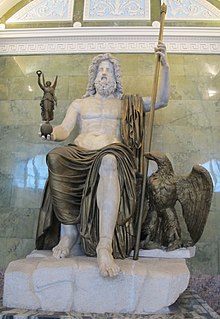
Jupiter, also known as Jove, is the god of the sky and thunder and king of the gods in ancient Roman religion and mythology. Jupiter was the chief deity of Roman state religion throughout the Republican and Imperial eras, until Christianity became the dominant religion of the Empire. In Roman mythology, he negotiates with Numa Pompilius, the second king of Rome, to establish principles of Roman religion such as offering, or sacrifice.
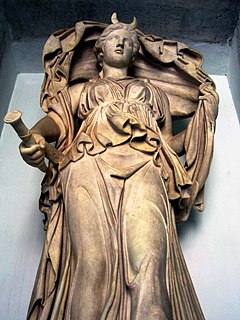
In ancient Roman religion and myth, Luna is the divine embodiment of the Moon. She is often presented as the female complement of the Sun, Sol, conceived of as a god. Luna is also sometimes represented as an aspect of the Roman triple goddess, along with Proserpina and Hecate. Luna is not always a distinct goddess, but sometimes rather an epithet that specializes a goddess, since both Diana and Juno are identified as moon goddesses.
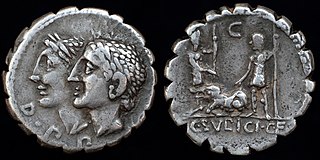
In ancient Roman religion, the Di Penates or Penates were among the dii familiares, or household deities, invoked most often in domestic rituals. When the family had a meal, they threw a bit into the fire on the hearth for the Penates. They were thus associated with Vesta, the Lares, and the Genius of the paterfamilias in the "little universe" of the domus.

Saturnalia was an ancient Roman festival and holiday in honour of the god Saturn, held on 17 December of the Julian calendar and later expanded with festivities through to 23 December. The holiday was celebrated with a sacrifice at the Temple of Saturn, in the Roman Forum, and a public banquet, followed by private gift-giving, continual partying, and a carnival atmosphere that overturned Roman social norms: gambling was permitted, and masters provided table service for their slaves as it was seen as a time of liberty for both slaves and freedmen alike. A common custom was the election of a "King of the Saturnalia", who would give orders to people, which were to be followed and preside over the merrymaking. The gifts exchanged were usually gag gifts or small figurines made of wax or pottery known as sigillaria. The poet Catullus called it "the best of days".
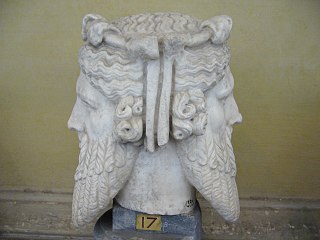
In ancient Roman religion and myth, Janus is the god of beginnings, gates, transitions, time, duality, doorways, passages, frames, and endings. He is usually depicted as having two faces. It is conventionally thought that the month of January is named for Janus (Ianuarius), but according to ancient Roman farmers' almanacs Juno was the tutelary deity of the month.

Festivals in ancient Rome were a very important part of Roman religious life during both the Republican and Imperial eras, and one of the primary features of the Roman calendar. Feriae were either public (publicae) or private (privatae). State holidays were celebrated by the Roman people and received public funding. Games (ludi), such as the Ludi Apollinares, were not technically feriae, but the days on which they were celebrated were dies festi, holidays in the modern sense of days off work. Although feriae were paid for by the state, ludi were often funded by wealthy individuals. Feriae privatae were holidays celebrated in honor of private individuals or by families. This article deals only with public holidays, including rites celebrated by the state priests of Rome at temples, as well as celebrations by neighborhoods, families, and friends held simultaneously throughout Rome.

The College of Pontiffs was a body of the ancient Roman state whose members were the highest-ranking priests of the state religion. The college consisted of the Pontifex Maximus and the other pontifices, the Rex Sacrorum, the fifteen flamens, and the Vestals. The College of Pontiffs was one of the four major priestly colleges; originally their responsibility was limited to supervising both public and private sacrifices, but as time passed their responsibilities increased. The other colleges were the augurs, the quindecimviri sacris faciundis , and the Epulones.

In ancient Roman religion, the rex sacrorum was a senatorial priesthood reserved for patricians. Although in the historical era, the pontifex maximus was the head of Roman state religion, Festus says that in the ranking of the highest Roman priests, the rex sacrorum was of highest prestige, followed by the flamines maiores and the pontifex maximus. The rex sacrorum was based in the Regia.
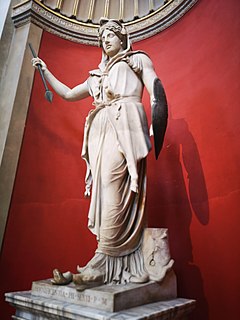
Juno was an ancient Roman goddess, the protector and special counsellor of the state. She was equated to Hera, queen of the gods in Greek mythology. A daughter of Saturn, she was the wife of Jupiter and the mother of Mars, Vulcan, Bellona and Juventas. Like Hera, her sacred animal was the peacock. Her Etruscan counterpart was Uni, and she was said to also watch over the women of Rome. As the patron goddess of Rome and the Roman Empire, Juno was called Regina ("Queen") and was a member of the Capitoline Triad, centered on the Capitoline Hill in Rome, and also including Jupiter, and Minerva, goddess of wisdom.

Fauna[ˈfau̯na] is a Roman rustic goddess said in differing ancient sources to be the wife, sister, or daughter of Faunus. Varro regarded her as the female counterpart of Faunus, and said that the fauni all had prophetic powers. She is also called Fatua or Fenta Fauna.

In ancient Roman religion, the Compitalia was a festival celebrated once a year in honor of the Lares Compitales, household deities of the crossroads, to whom sacrifices were offered at the places where two or more ways meet. The word comes from the Latin compitum, a cross-way.

Vulcan is the god of fire including the fire of volcanoes, deserts, metalworking and the forge in ancient Roman religion and myth. He is often depicted with a blacksmith's hammer. The Vulcanalia was the annual festival held August 23 in his honor. His Greek counterpart is Hephaestus, the god of fire and smithery. In Etruscan religion, he is identified with Sethlans.

The Legislative Assemblies of the Roman Kingdom were political institutions in the ancient Roman Kingdom. While one assembly, the Curiate Assembly, had some legislative powers, these powers involved nothing more than a right to symbolically ratify decrees issued by the king. The functions of the other assembly, the Calate Assembly, was purely religious. During the years of the kingdom, the People of Rome were organized on the basis of units called curiae. All of the People of Rome were divided amongst a total of thirty curia, and membership in an individual curia was hereditary. Each member of a particular family belonged to the same curia. Each curia had an organization similar to that of the early Roman family, including specific religious rites and common festivals. These curia were the basic units of division in the two popular assemblies. The members in each curia would vote, and the majority in each curia would determine how that curia voted before the assembly. Thus, a majority of the curia was needed during any vote before either the Curiate Assembly or the Calate Assembly.
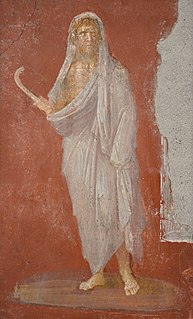
Saturn was a god in ancient Roman religion, and a character in Roman mythology. He was described as a god of generation, dissolution, plenty, wealth, agriculture, periodic renewal and liberation. Saturn's mythological reign was depicted as a Golden Age of plenty and peace. After the Roman conquest of Greece, he was conflated with the Greek Titan Cronus. Saturn's consort was his sister Ops, with whom he fathered Jupiter, Neptune, Pluto, Juno, Ceres and Vesta.

The vocabulary of ancient Roman religion was highly specialized. Its study affords important information about the religion, traditions and beliefs of the ancient Romans. This legacy is conspicuous in European cultural history in its influence on later juridical and religious vocabulary in Europe, particularly of the Western Church. This glossary provides explanations of concepts as they were expressed in Latin pertaining to religious practices and beliefs, with links to articles on major topics such as priesthoods, forms of divination, and rituals.
In ancient Roman culture, sigillaria were pottery or wax figurines given as traditional gifts during the Saturnalia. Sigillaria as a proper noun was also the name for the last day of the Saturnalia, December 23, and for a place where sigillaria were sold. A sigillarius was a person who made and sold sigillaria, perhaps as an offshoot of pottery manufacture.
Cornelius Labeo was an ancient Roman theologian and antiquarian who wrote on such topics as the Roman calendar and the teachings of Etruscan religion (Etrusca disciplina). His works survive only in fragments and testimonia. He has been dated "plausibly but not provably" to the 3rd century AD. Labeo has been called "the most important Roman theologian" after Varro, whose work seems to have influenced him strongly. He is usually considered a Neoplatonist.

The Amburbium was an ancient Roman festival for purifying the city; that is, a lustration (lustratio urbis). It took the form of a procession, perhaps along the old Servian Wall, though the length of 10 kilometers would seem impractical to circumambulate. If it was a distinct festival held annually, the most likely month is February, but no date is recorded and the ritual may have been performed as a "crisis rite" when needed.